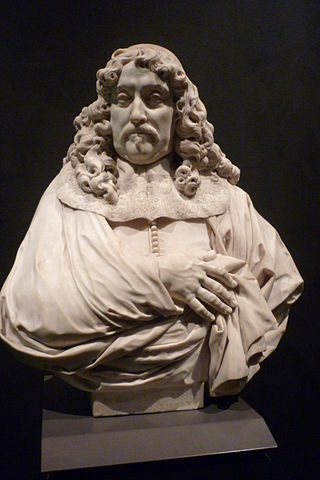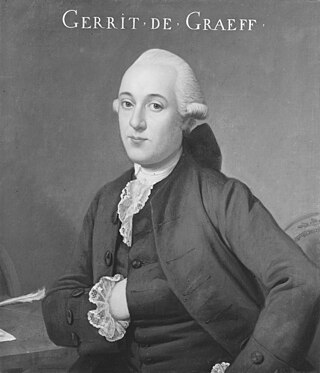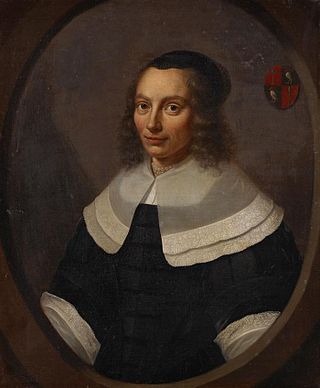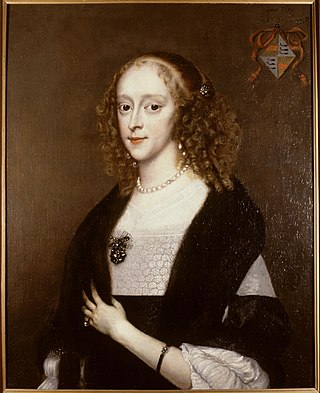
Jacoba Bicker (Amsterdam, January 2, 1640 - June 29, 1695) was from the Bicker family, which was one of the leading pro-state families in the Dutch Golden Age.

Jacoba Bicker (Amsterdam, January 2, 1640 - June 29, 1695) was from the Bicker family, which was one of the leading pro-state families in the Dutch Golden Age.
Jacoba Bicker was born as the daughter of Jan Bicker and his cousin Agneta de Graeff van Polsbroek, one of her sisters was Wendela Bicker, the wife of Grand pensionary Johan de Witt. [1] She had many well-known and important relatives; Andries de Graeff and the brothers Andries and Cornelis Bicker were her uncle, and Johan and Cornelis de Witt were her cousins. The protagonists of the patriciate were closely related, [2] and in 1663, at the age of 22, she married her other cousin Pieter de Graeff at Ilpenstein Castle. Grand pensionary De Witt was also present there and gave the wedding speech. [3] The poets Jan Vos, [4] Joost van den Vondel [5] and Gerard Brandt, [6] who were present, "sang about" this wedding.
The couple had three children: [2]
In 1663 Jacoba Bicker was painted together with her husband Pieter by Caspar Netscher and alone by Jurriaen Ovens. Wallerant Vaillant painted her in 1674 and Emanuel de Witte together with Pieter and daughter Agneta de Graeff in 1678. When her sister Wendela died in 1668, her husband Pieter and her brother-in-law Jean Deutz were appointed guardians of their nephews and nieces and were responsible for handling the estate. [8] In 1695 Jacoba Bicker was one of the 250 richest persons from the Dutch Golden Age and was assessed for a taxable capital of 491,811 guilders. [7]

Johan de Witt, lord of Zuid- en Noord-Linschoten, Snelrewaard, Hekendorp en IJsselvere, was a Dutch statesman and a major political figure in the Dutch Republic in the mid-17th century, the First Stadtholderless Period, when its flourishing sea trade in a period of globalization made the republic a leading European trading and seafaring power – now commonly referred to as the Dutch Golden Age. De Witt was elected Grand pensionary of Holland, and together with his uncle Cornelis de Graeff, he controlled the Dutch political system from around 1650 until the Rampjaar 1672. This progressive cooperation between the two statesmen, and the consequent support of Amsterdam under the rule of De Graeff, was an important political axis that organized the political system within the republic.

Cornelis de Graeff, often named Polsbroek or de heer van (lord) Polsbroek during his lifetime was an influential regent and burgomaster (mayor) of Amsterdam, statesman and diplomat of Holland and the Republic of the United Netherlands at the height of the Dutch Golden Age.

Catharina Pietersdr Hooft was a woman of the Dutch Golden Age. She became famous at a very early age, when she was painted by Frans Hals.

De Graeff is an old Dutch patrician and noble family,

Andries de Graeff was a regent and burgomaster (mayor) of Amsterdam and leading Dutch statesman during the Golden Age.

Pieter de Graeff, was a Dutch aristocrat of the Dutch Golden Age and one of the most influential pro-state, republican Amsterdam Regents during the late 1660s and the early 1670s before the Rampjaar 1672. As president-bewindhebber of the Dutch East India Company, he was one of the most important representatives and leaders of the same after the Rampjaar.

Ilpenstein Castle was a castle of the Free and high Lordship of Purmerend, Purmerland and Ilpendam, located in Ilpendam (Waterland) in the north of the city of Amsterdam.

Johan de Graeff, also Jan de Graeff - patrician of Amsterdam, Free Lord of Zuid-Polsbroek - was a member of the De Graeff - family from the Dutch Golden Age. His political Position was that of the Dutch States Party.

Gerrit de Graeff belonged to the patrician class of Amsterdam and held the feudal titles Free Lord of Zuid-Polsbroek as those of 21st Purmerland and Ilpendam. Known for his wealth and notorious for his stinginess, De Graeff was not particularly popular.
Cornelis de Graeff was a member of the family De Graeff, a prominent regent family from the Dutch Golden Age. He hold the title 20st Free Lord of Purmerland and Ilpendam.

The Free or high Lordship of Purmerend and Purmerland and after 1618 Purmerland and Ilpendam was a type of local jurisdiction with many rights.

Jan Gerritsz. Bicker (1591–1653) was a merchant, mayor (burgomaster) and a member of the Bicker family, an influential patrician family of regenten from Amsterdam.

Jacob Dircksz de Graeff, free lord of Zuid-Polsbroek was an illustrious member of the Dutch patrician De Graeff family. He belonged to States Faction and was an influential Amsterdam regent and burgomaster (mayor) of the Dutch Golden Age.

Jacob de Graeff was a member of the De Graeff-family from the Dutch Golden Age. He was an Amsterdam regent and held the title as 20th Free Lord of Ilpendam and Purmerland.

Maria Overlander van Purmerland was a noble from the Dutch Golden Age and Free Lady of Purmerland and Ilpendam. She was married to Frans Banninck Cocq captain of Rembrandts painting The Night Watch.

Agneta de Graeff van Polsbroek, was a patrician woman from the Dutch Golden Age. She became known as the mother-in-law of Johan de Witt.
This is family tree of the Dutch (De) Graeff family. The House De Graeff is an alleged cadet branch of the House Von Graben that descended from the Austrian noble Wolfgang von Graben (1465–1521).

Wendela Bicker was the wife of Johan de Witt. She was one of the richest young female commoners of her time and she married one of the most influential republican politicians in the Netherlands. She was in the public eye during her lifetime and entered history books thereafter. This is facilitated by the letters and the housekeeping books she left behind. The narrative about her life reflects how the role of women in the Netherlands in the 17th century was and is understood.

Gerard Bicker (I) van Swieten, Lord of Swieten was a Dutch aristocrat and civil servant.

Jean Deutz was a Dutch merchant, banker and financier of his brother-in-law Grand pensionary Johan de Witt.